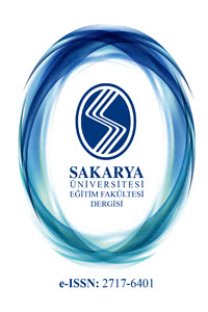Fen Bilgisi Öğretmen Adaylarının Projeye Dayalı Öğrenme Yaklaşımı İle İlgili Tutumları
Bu çalışmanın amacı, Projeye Dayalı Öğrenme (PDÖ) yaklaşımına dayalı olarak yürütülen Fen, Teknoloji ve Toplum (FTT) dersini alan fen bilgisi öğretmen adaylarının PDÖ yaklaşımı hakkındaki tutumlarını tespit etmektir. FTT dersi haftada 3 saat olmak üzere 14 hafta sürmüştür. Çalışmaya, 36 son sınıf fen bilgisi öğretmen adayı katılmıştır. Dönem sonunda öğretmen adaylarının PDÖ tutumlarını belirlemek için PDÖ tutum testi Türkçe ‘ye uyarlanarak uygulanmıştır. Sonuç olarak, öğretmen adaylarının PDÖ yaklaşımı hakkında olumlu tutumlara sahip oldukları belirlenmiştir. Öğretmen adaylarının, gruplarında çalışmalarına yeterince katkıda bulunmayan öğretmen adaylarından ve zaman baskısından şikâyetçi oldukları ve süreçte daha çok rehberliğe ihtiyaç duydukları belirlenmiştir. “Öğretmenler kendilerine öğretildiği gibi öğretme eğilimindedirler” ilkesi göz önüne alındığında, eğitim fakültelerinde dersler PDÖ gibi aktif ve öğrenci merkezli yaklaşımlarla yürütülmeye çalışılmalıdır. Derslerin buna benzer yaklaşımlarla yürütülmesi, sadece bu yaklaşımların dayandığı teorik temellerin öğretiminden daha etkili olacaktır. Uygulamanın nasıl yürütüldüğü ile ilgili ayrıntılı bilgiler ve ayrıntılı sonuçlar ayrıca sunulacaktır.
Anahtar Kelimeler:
Projeye dayalı öğrenme, Fen bilgisi öğretmen adayları, PDÖ tutum ölçeği
-
The aim of this study was to investigate pre‐service science teachers’ attitudes toward Project Based Learning (PBL) approach after they participated in a Science, Technology and Society (STS) course, which were carried out based on PBL. STS course was 3 hours per week, during 14 weeks term. The sample of the study consisted of 36 senior pre‐service science teachers. At the end of the term to determine the attitudes of pre‐service teachers toward PBL, the attitude test for PBL have been adapted to Turkish language and applied to the sample. As the result, it was found that pre‐service teachers have a positive attitude about the PBL approach. It has also been determined that pre‐service teachers complained about groups of their peers, who did not contribute enough to the project work, and time pressure and they need more guidance in the process. Given the policy "Teachers tend to teach as they were taught”, courses for pre‐service teacher education should be carried out with active and student‐centered approaches such as PBL. Teaching courses with a similar approach will be more effective than only teaching the theoretical foundations of this approach. More information on how the application was implemented and detailed results will also be presented.
Keywords:
-,
___
- Abd‐El‐Khalick, F. (2001). Embedding Nature of Science Instruction in
- Preservice Elementary Science Courses: Abandoning Scientism, But.
- Journal of Science Teacher Education, 12(3), 215‐233.
- Arends, R. (2007). Learning to teach (Sixth Edition ed.): McGraw‐Hill New York
- Asghar, A., Ellington, R., Rice, E., Johnson, F., & Prime, G. M. (2012). Supporting
- STEM Education in Secondary Science Contexts. Interdisciplinary
- Journal of Problem‐based Learning, 6(2), 4.
- Bourner, J., Hughes, M., & Bourner, T. (2001). First‐year undergraduate
- experiences of group project work. Assessment & Evaluation in Higher
- Education, 26(1), 19‐39.
- Çelik, S., Şenocak, E., Bayrakçeken, S., Taşkesenligil, Y., & Doymuş, K. (2005).
- Aktif öğrenme stratejileri üzerine bir derleme çalışması. Atatürk
- Üniversitesi Kâzım Karabekir Eğitim Fakültesi Dergisi, (11), 155‐185.
- Fleming, D. (2000). A Teacher’s Guide to Project Based Learning. AEL. Inc.,
- Chaleston, WV.
- Frank, M., & Barzilai, A. (2004). Integrating alternative assessment in a projectbased
- learning course for pre‐service science and technology teachers.
- Assessment & Evaluation in Higher Education, 29(1), 41‐61.
- Frank, M., Lavy, I., & Elata, D. (2003). Implementing the project‐based learning
- approach in an academic engineering course. International Journal of
- Technology and Design Education, 13(3), 273‐288.
- Garvin, J., Butcher, A., Stefani, L., Tariq, V., Lewis, M., Blumson, N., . . . Hill, J.
- (1995). Group projects for first‐year university students: an evaluation.
- Assessment & Evaluation in Higher Education, 20(3), 273‐288.
- Juhl, L., Yearsley, K., & Silva, A. J. (1997). Interdisciplinary project‐based
- learning through an environmental water quality study. Journal of
- Chemical Education, 74(12), 1431.
- Karaman, S., & Celik, S. (2008). An Exploratory Study on the Perspectives of
- Prospective Computer Teachers following Project‐Based Learning.
- International Journal of Technology and Design Education, 18(2), 203‐
- -
- The Journal of SAU Education Faculty, 27 (May 2014)
- Kim, P., Hong, J. S., Bonk, C., & Lim, G. (2011). Effects of group reflection
- variations in project‐based learning integrated in a Web 2.0 learning
- space. Interactive Learning Environments, 19(4), 333‐349.
- Kolmos, A. (1996). Reflections on project work and problem‐based learning.
- European Journal of Engineering Education, 21(2), 141‐148.
- Markham, T. (2003). Project based learning handbook: A guide to standardsfocused
- project based learning for middle and high school teachers:
- Buck Institute for Education.
- Marx, R. W., Blumenfeld, P. C., Krajcik, J. S., & Soloway, E. (1997). Enacting
- project‐based science. The elementary school journal, 341‐358.
- Mergendoller, J. R., & Thomas, J. W. (2001). Managing project based learning:
- Principles from the field. Buck Institute for Education. Available:
- http://www. bie. org.
- Mills, P. (2003). Group project work with undergraduate veterinary science
- students. Assessment & Evaluation in Higher Education, 28(5), 527‐
- -
- Mioduser, D., & Betzer, N. (2008). The contribution of Project‐based‐learning
- to high‐achievers’ acquisition of technological knowledge and skills.
- International Journal of Technology and Design Education, 18(1), 59‐
- -
- Newell, R. J. (2003). Passion for learning: How project‐based learning meets the
- needs of 21st‐century students (Vol. 3): Rowman & Littlefield
- Education.
- Özdener, N., & Özçoban, T. (2004). A project based learning model's
- effectiveness on computer courses and multiple intelligence theory.
- Educational Sciences: Theory & Practice, 4(1), 176‐180.
- Rutherford, F. J., & Ahlgren, A. (1990). Science for all Americans: Oxford
- University Press, USA.
- Solomon, G. (2003). Project‐based learning: A primer. Technology and
- Learning‐Dayton, 23(6), 20‐20.
- Thomas, J. W. (2000). A review of research on project‐based learning. San
- Rafael, CA: Autodesk Foundation. Retrieved April, 13, 2003
- ISSN: 1303-0310
- Yayın Aralığı: Yılda 2 Sayı
- Başlangıç: 2001
- Yayıncı: Sakarya Üniversitesi
